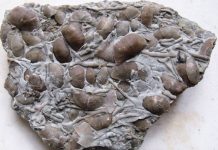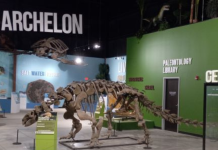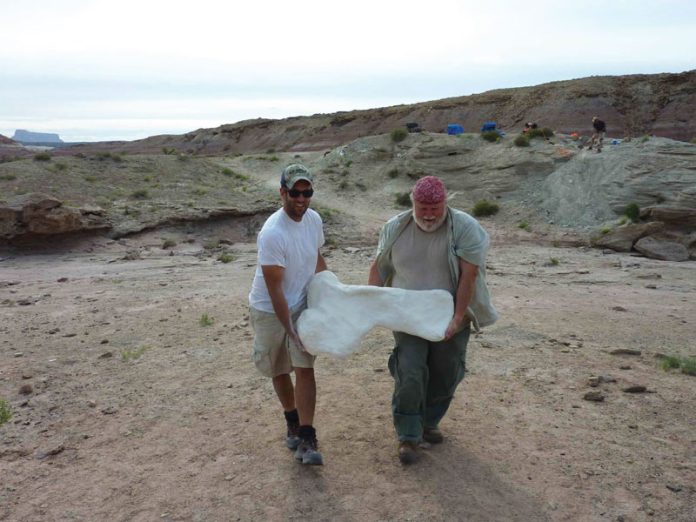
Digging for dinosaur bones, from pedestalling to jacketing and removing, is a process that scientists use to protect the bones and learn as much about the fossilized dino as possible.
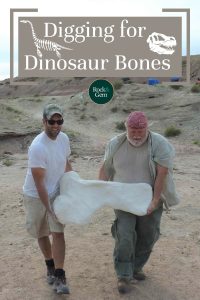
Finding Dinosaurs
In the past, paleontologists would spend a great deal of time prospecting, walking along the face of the earth looking for evidence of bones. That evidence is usually a fragment of a bone or what is called a “float.” These are little pieces of bone that have migrated to the surface – or the last bone fragment as it weathers to dust. That is an indicator of dinosaur bones. The float is followed uphill to the rest of the bones.
Rarely are complete dinosaurs discovered. Then as now, scavengers roamed the earth. They would consume the bodies of dead dinosaurs and scatter bones around the ground. Dinosaurs walking around the carcass often would step on bones shattering them into pieces. Often bone beds are located near rivers and the flowing waters would carry many bones away. It is a lucky crew that finds even fifty percent of a dinosaur skeleton.
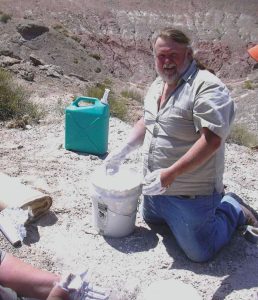 Digging Tools
Digging Tools
Generally, bulldozers and backhoes are not used while surface prospecting because they would destroy the bones. Once bone material is found, out come the brushes. One- and two-inch paint brushes are used to brush away sand and sediment in search of more bone material. At times just below the surface overburden (dirt, rocks, and detritus that cover the bones), fairly complete bones are found.
Once a bone is discovered, be it in rock or softer sediment, a trench is dug around the bone at a minimal distance. In rock, air tools like a mini handheld jackhammer, are used. In softer sediment, the dirt and sand fall away easily with a brush, old screwdriver, or icepick. As the bone is being exposed, various stabilizing liquids are applied because of the brittleness of the bone. The liquids used vary from digger to digger and crew to crew, but generally, they are some form of glue. Often these glues and stabilizers are mixed and created onsite by the crews. As the stabilizer enters the bone, the liquid quickly evaporates leaving the hard stabilizer behind within the bone.
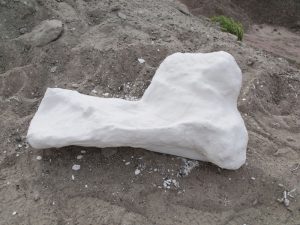 Jacketing Dinosaur Finds
Jacketing Dinosaur Finds
Once the bone has been stabilized, the jacketing process begins. First tin foil or some other material is placed over the bone so that the plaster jacket can be removed easily. Plaster of Paris is brought to the field in dry form, mixed with water in buckets, and strips of burlap are cut and saturated with the Plaster of Paris. The saturated strips are placed over the tin foil-covered bone.
This process is repeated until the entire top surface and as many of the sides are covered as possible. At this point, the bone is undercut and more material is removed until the bone is just barely held in place by the remaining sediment. At times, transverse holes are dug under the bone from one side to the other and burlap is wrapped underneath to further stabilize the bone. After the plaster has dried solid, the bone is gently rocked until it is almost free and then rolled over very quickly, and hopefully, intact. Once free, the other side is also jacketed, and the bone can safely be removed from the dig site.
Removing Lots of Bones
Sometimes pods need to be jacketed. Large amounts of bones are jacketed together at times weighing hundreds, even thousands of pounds. Then heavy equipment is necessary to remove the pods to the back of flatbeds for transport. Tactics, tools, equipment, stabilizers, and glues vary from crew to crew, but the process is generally the same. The goal is to remove the fossil with the least amount of damage possible so the bones can be used for research, study, or display.
This story about digging for dinosaur bones previously appeared in Rock & Gem magazine. Click here to subscribe! Story by Joseph “Paleojoe” Kchodl.


